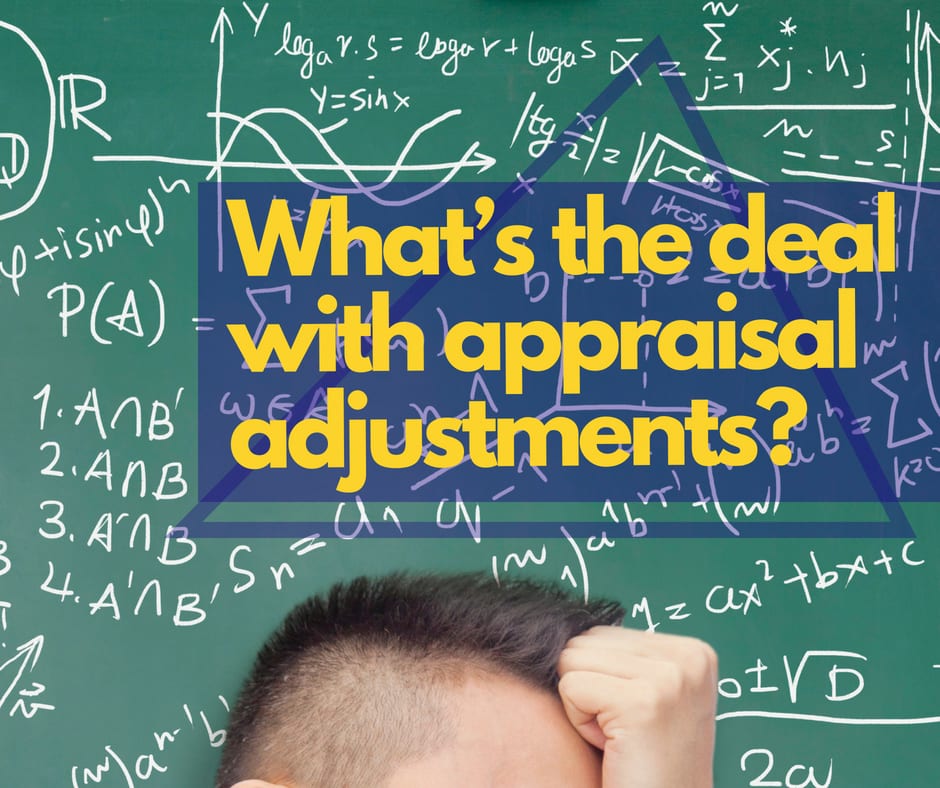What’s the deal with appraisal adjustments?
Categories: Real Estate Appraisal
Probably the most common issue we hear with appraisals is the amount and type of adjustments. Homeowners, agents, and lenders alike tend to question reports and ask questions about the amount of adjustments.
Condition, location, closing/contract date, and features are given a lot of attention for the amount of adjustments. If you’re involved with the real estate business, you know how much scrutiny appraisals and their preparers get for valuations that come in lower than expected.
What is an adjustment?
An adjustment, as it relates to appraisal (not chiropracty), is a small line-item subtraction or addition to the value of a comparable to account for changes in demand attributable to each internal and external factor.
Each comparable or difference taken individually won’t provide a sufficient basis for estimating the value of the property (another point about this in a moment), but when a selection of active and sold comparables are adjusted, it provides strong statistical support for an estimate of value that accurately represents market value.
The more accurate the adjustments and the quality/similarity of the comparables, the narrower the range of possible value and the more accurate the report. This is why professional independent appraisers place so much emphasis on collecting substantial and relevant market data to make the most accurate adjustments and final reconciliations.
Estimate of value?
An appraisal or valuation is a professional opinion of the value of an asset at a given point in time. The estimate can be derived after adjusting the comparables through a process called reconciliation using statistical approaches.
How do appraisers figure out how much to adjust comparables for things like better condition, less utility, settlement date, or superior location?
The most basic way is by studying the local market (direct observation) to understand how differences uniquely influence value in a submarket. More scientific valuation firms will employ a statistical regression method known as paired analysis to study how specific property features affect value between numerous pairs of properties sharing the same differences.
Let’s clear the air about time-based adjustments. This is an adjustment that works a little differently than other physical characteristic adjustments. If your sold comparable seems like it’s the perfect match for your subject, and would really put over the value you need to get funded, BUT, the contract or closing date is more than six months past (or less in rapid markets), make sure the appraiser considers adjustments for appreciation.
Adjusting for Time
The adjustment is calculated by adjusting the value of the comparable by the rate of annual appreciation, divided by 12, times the number of months since it was sold or went under contract.
Example
A $500K comparable property sold 7 months ago might have this adjustment: 7% annual appreciation/12 months*7months* the value of the property:
[(.07/12)*7]x500,000=.041×500,000=+$20,417
As you can see, these values are very realistic for many markets and an adjustment for time can give a major boost to your valuation.
Contract Date vs Closing Date
Depending on the particulars of the property or transaction, contract date or closing date may be more important in evaluating the suitability of and estimating the adjustments for a sold comparable. Contract date is important to consider when comparing properties as the market is constantly fluctuating. Closing dates are also considered, but often delays in funding and closing result in settlement dates that don’t reflect the market period influencing the contracted price.
Another thing to note is that when comparables are superior to the subject (the property being appraised), the estimated difference in value is subtracted from the value of the comparable. A good example here is if the comparable has a pool and the subject does not: we would subtract the estimated market value of the pool (not the construction cost) from the comparable.
After making adjustments for numerous factors, we begin to get a very clear idea about the likely value of our subject property, especially when the market is brisk and many sold and active comparables are available for analysis.
The numbers should make sense.
So it’s not that complicated after all; however, it does take a tremendous amount of experience and insight (and not the least of all: licensing, certification, apprenticeship, and hundreds of hours of practice). Don’t take it for granted that the appraiser assigned by the lender, or dispatched by the conglomerate appraisal management company in the region, knows what they’re doing when it comes to reconciling values in a dynamic local market. It’s okay to questions values and the logic behind the assumptions underlying a report.
When you work with valuations professionals that offer value, insight, diligence, and transparency, you can expect to have your questions answered and feel certain about the accuracy of your valuation. In the high-value field of real estate, the quality of appraisals plays a key role in investment decisions and their outcomes.





I appreciated it when you shared that an appraisal is done by a professional who will give an opinion of the value of an asset at a given point in time. It is great to make sure to understand how much claim that is needed to be done. I would like to think if a trucking company needs to file for a claim in case of a truck accident, it could cosdneir working with a reliable appraisal service.